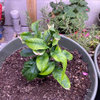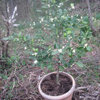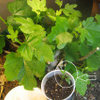citrus disease? Please help
nattayam
9 years ago
Related Stories

GARDENING GUIDESHow to Keep Your Citrus Trees Well Fed and Healthy
Ripe for some citrus fertilizer know-how? This mini guide will help your lemon, orange and grapefruit trees flourish
Full Story
GARDENING GUIDESTree Care: Common Tree Diseases and What to Do About Them
Learn to recognize trees that may be affected by diseases or pests so you can quickly take action
Full Story
GARDENING GUIDESSpring Citrus Care Reaps Months of Sweet Rewards
Learn how to tend citrus trees in spring and ways to preserve their delicious fruit
Full Story
GARDENING AND LANDSCAPINGCitrus 101: Start Your Own Backyard Orchard
This Earth Day Weekend, Add Some Green, Style and Deliciousness to Your Landscape
Full Story
GARDENING GUIDESGreat Design Plant: Snowberry Pleases Year-Round
Bright spring foliage, pretty summer flowers, white berries in winter ... Symphoricarpos albus is a sight to behold in every season
Full Story
GARDENING GUIDES9 Fresh Herbs for Crowd-Pleasing Thanksgiving Dishes
Pluck these herbs from a windowsill pot or a garden for a Thanksgiving meal that sings with fresh flavor
Full Story
WINTER GARDENINGHow to Help Your Trees Weather a Storm
Seeing trees safely through winter storms means choosing the right species, siting them carefully and paying attention during the tempests
Full Story
MOST POPULAR7 Ways to Design Your Kitchen to Help You Lose Weight
In his new book, Slim by Design, eating-behavior expert Brian Wansink shows us how to get our kitchens working better
Full Story
UNIVERSAL DESIGNMy Houzz: Universal Design Helps an 8-Year-Old Feel at Home
An innovative sensory room, wide doors and hallways, and other thoughtful design moves make this Canadian home work for the whole family
Full Story
EARTH DAYHow to Help Your Town’s Beneficial Birds and Bugs
Make a habitat using local materials to provide a home to the creatures that help our gardens
Full StoryMore Discussions










nattayamOriginal Author
hoosierquilt USDA 10A Sunset 23 Vista CA
Related Professionals
Horsham Landscape Architects & Landscape Designers · New Mexico Landscape Architects & Landscape Designers · Chelmsford Landscape Contractors · Choctaw Landscape Contractors · College Park Landscape Contractors · Dickinson Landscape Contractors · East Chicago Landscape Contractors · Edwardsville Landscape Contractors · Lees Summit Landscape Contractors · Longmont Landscape Contractors · Lynn Landscape Contractors · Mendota Heights Landscape Contractors · Milford Mill Landscape Contractors · Stallings Landscape Contractors · Clearfield Landscape Contractorshoustontexas123
nattayamOriginal Author
evdesert 9B Indio, CA
hoosierquilt USDA 10A Sunset 23 Vista CA